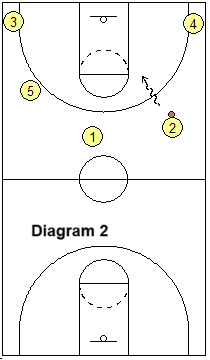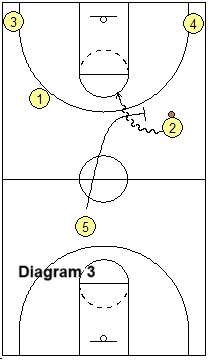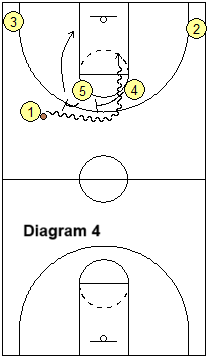Pace and Space Basketball Offense
By Dr. James Gels, From the Coach’s Clipboard Basketball Playbook"Helping coaches coach better..."
Disclosure: This page contains affiliate links, which means that Coach's Clipboard receives a small commission (at no cost to you) if you make a purchase using these links.
The 3-point line has changed basketball, more so now than ever. At the pro level, gone are the days of slow, methodical play with back-to-the-basket big men and half-court sets. Today's game is fast and driven by two key concepts: pace and space. The "Pace and Space" offense has become big at the pro level — but is also gaining headway in college, high school and even youth basketball. It builds on the idea of positionless basketball.

Pace
Pace is about playing fast and pushing the ball up the court as fast as possible, fast-breaking, before the defense can get set. This can happen after a turnover or a rebound. With rebounding, we want a quick outlet pass and speed dribbling or quick passing up the court, trying to score within the first 6 - 10 seconds of the shot clock.Playing fast with early offense results in more possessions and more shot attempts. The fast-break can produce easy lay-ups, mis-matches, and open 3-point shots. Pushing the ball up the floor quickly puts pressure on the opponent to get back.
Space
Space is about positioning players around the 3-point arc so that the inside is open, the defense is stretched and there is less opportunity for defensive help. This includes moving your "bigs" (O4 and O5) to the perimeter in a 5-out set, or a high horns set, or perhaps a 4-out, 1-in set if one post player just cannot play on the outside. This post player can be active as a ball-screener and roller, while still trying to keep from clogging the inside. High ball-screens, players in the corners (to stretch the defense), and constant movement are hallmarks.Players try to score with either the open 3-point shot, or by dribble-penetration for a lay-up or a kickout pass to an open 3-point shooter. Mid-range jump-shots are not a big part of this offense.
Spacing pulls defenders away from the hoop, creates lanes for the dribble-drive and kick, and forces the defense to cover more ground, with less defensive help.
Point guards must be able to push, dribble-penetrate, create plays and score. Wings have to be good 3-point shooters, cutters and be able to dribble-drive. Post players can set screens and roll or pop. Post players are now becoming 3-point threats as well.
When the fast-break is stopped, the offense quickly moves into action, often with a high ball-screen pick and roll/pop or a dribble-drive penetration. Keys are quick ball-movement, passing, player movement with cutting, rotating and filling open perimeter spaces - no holding the ball. It's harder to guard players who are moving - not standing still. Dribbling is only permitted to advance the ball and in attacking with the dribble-drive.
The diagrams below show several actions that can be used to trigger your 5-out offense right after the fast-break is stopped. Also see the Duke and Fred Hoiberg transition and early offense options linked below.
High Pick and Roll
Diagram 1 shows a high pick and roll with O5 ball-screening for O1. O1 attacks as O5 rolls to the hoop. A kickout pass to O3 is an option. The pick and roll is very effective with the great spacing.

Dribble-drive
Diagram 2 shows O2 having a chance to dribble-attack a wide gap. This might occur with O4 and O5 already in position after an opponent's made free-throw, or after an inbounds situation (after a make or turnover).Drag-Screen
Diagram 3 shows a situation after a rebound, where again the fast-break is stopped. The rebounder O5 trailing the play sets a drag screen for O2 and they run either a pick and roll, or a pick and pop (O5 spaces out to the 3-point arc).

Horns Action
Diagram 4 shows another early action where a high horns set is used, with O4 and O5 high. Here they set a double staggered screen for O1. The first screener O5 slips the screen and cuts inside for a pass from O1. The second screener O4, pops to the 3-point arc after the screen. O1 attacks with the dribble for a lay-up, or a pass to O5, O2, or back to O4.Pistols Action
You can also start the 5-out offense with a pistols action, involving interaction between the point guard and wing. This could start with a dribble entry or a pass to the wing. There are several screening options, hand-offs, etc - see Pistol Action Plays.Problems for the Defense
This offense creates a lot of problems for the defense. The uptempo push creates pressure on the defense to get back. Fatigue becomes an issue.With the wide spacing, the defense is stretched out, and traditional help defense is often not there. Defenders must be good individual defenders, and be good at closing out on the arc, and containing the ball without help... not easy.
The pick and roll is hard to defend because of the spacing and difficulty of getting inside help.
Some personal thoughts
It's a great offense at the pro and collegiate level where you have a whole team of great "positionless" players. Fun to watch.Youth players can't shoot the 3 yet and are not as skilled in ball-handling, making decisions and playing fast. So no, but you can start teaching them positionless basketball and put them on the path.
High school teams may have a few good 3-point shooters, but you need more than a few as the pace of the game will require you to use your bench, maybe 8 or 10 deep. Late in the game, 3-point shooting percentages often decline when players have tired legs. I've seen high school teams "light it up" the first half, but go cold the second half. And in post-season tournament play, one cold night and you're done... "live by the 3, die by the 3."
Less skilled teams will be faced with more turnovers, when trying to play faster than they are capable. "Be quick, but never hurry." - John Wooden.
Also see this video and link:
Keno Davis: Space and Pace Offense DVD
Related pages:
Keno Davis: Space and Pace Offense DVD
Related pages:
- Concepts for Playing Fast
- Transition Offense, Fast-Break Offense
- Basketball Small Ball
- Secondary Numbered Break
- Duke Transition and Early Motion Offense Options
- Fred Hoiberg's Transition to Early Offense
- 4-On-4-On-4 Full-Court Transition Drill
- Transition Offense, Fast-Break Drills